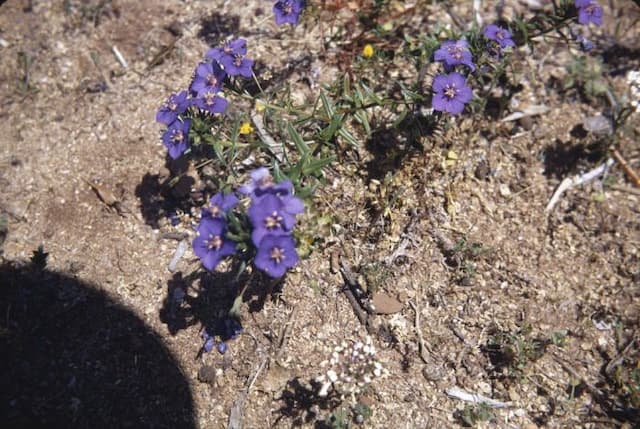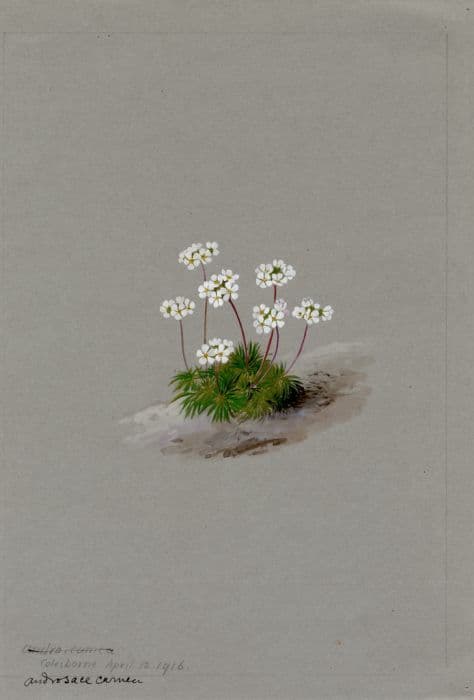Auricula Primula auricula 'Piers Telford' (Au/a)

ABOUT
The Primula auricula 'Piers Telford'—commonly known as the auricula primrose—has a distinctive appearance that sets it apart from other primrose varieties. The plant features a rosette of soft, green leaves that provide a lush backdrop for its striking flowers. These blooms have a unique character, typically with shades of deep, rich purple that captivate onlookers. The center of each flower is a contrasting, bright yellow or golden eye, which makes the purple tones pop even more vibrantly. The petals can sometimes exhibit a dusting or powdery coating known as 'farina,' giving them a frosted look that adds to their charm. The flowers are known for their ornamental appeal and are highly prized by gardeners and plant enthusiasts for their bold colors and elegant form.
About this plant
 Names
NamesFamily
Primulaceae.
Synonyms
Auricula, Mountain Cowslip, Bear's Ear.
Common names
Primula auricula 'Piers Telford'
 Toxicity
ToxicityTo humans
Auricula is the most common name for the Primula auricula 'Piers Telford'. Generally, auriculas are not considered highly toxic to humans. However, they can contain compounds that may cause mild irritation or allergic reactions in some individuals. If ingested, parts of the plant can potentially cause symptoms like nausea, vomiting, or diarrhea. It's important to avoid eating this plant and to wash hands after handling it, especially if you have sensitive skin.
To pets
Auricula is the most common name for the Primula auricula 'Piers Telford'. This plant is not significantly toxic to pets, but it can cause mild gastrointestinal upset if ingested. Symptoms of poisoning might include vomiting or diarrhea. As with humans, it is advisable to prevent pets from ingesting parts of this plant to avoid any potential discomfort.
 Characteristics
CharacteristicsLife cycle
Perennials
Foliage type
Evergreen
Color of leaves
Green
Flower color
Varies
Height
6 inches (15 cm)
Spread
6 inches (15 cm)
Plant type
Herb
Hardiness zones
5
Native area
Europe
Benefits
 General Benefits
General Benefits- Ornamental Appeal: The Primula auricula 'Piers Telford', commonly known as "Bear's Ear," features distinctively shaped leaves resembling a bear's ear, adding unique visual interest to gardens.
- Colorful Blooms: It produces vibrant, multi-colored flowers that enhance the aesthetic of any garden or landscape.
- Extended Blooming Season: This variety often has a longer flowering period, providing color from early to late spring.
- Attracts Pollinators: The flowers attract bees and butterflies, which are essential for pollinating other plants in the garden.
- Hardy Nature: Bear's Ear is known for its hardiness, making it suitable for growing in a variety of climates and conditions.
- Low Maintenance: This plant is relatively easy to care for, requiring minimal maintenance once established.
- Compact Growth: Its compact size is ideal for rock gardens, borders, and small spaces where a less sprawling plant is desired.
- Container Gardening: Suitable for pots and containers, allowing for flexibility in garden design and the ability to bring color to patios and balconies.
 Medical Properties
Medical PropertiesThis plant is not used for medical purposes.
 Air-purifying Qualities
Air-purifying QualitiesThis plant is not specifically known for air purifying qualities.
 Other Uses
Other Uses- Primula auricula 'Piers Telford' is used in creating a natural dye for fabrics, with different parts of the plant producing varying shades of yellow and green.
- These plants can be used in perfumery due to their sweet fragrance, especially to infuse oils and create natural potpourris.
- Auricula flowers are edible and can make colorful, slightly spicy additions to salads and desserts, offering a unique culinary experience.
- The sturdy leaves of the auricula can be used as natural molds for crafting decorative soaps and candles.
- Auricula flowers can be pressed and included in paper making to add texture and visual interest to handmade paper products.
- The blossoms are sometimes used in crafting eco-friendly confetti for events, as they are biodegradable and more environmentally friendly than synthetic alternatives.
- These flowers can also be used for educational purposes in botany and horticulture to study Alpine plant adaptations and pollination biology.
- Primula auricula 'Piers Telford' can be featured in floral art, such as ikebana, due to its distinctive shape and vibrant colors.
- The flowers serve as excellent subjects for botanical illustration and photography, offering a way to promote biodiversity through art.
- In folklore, planting auricula flowers might be considered to bring good luck to the gardeners and their homes in some cultures.
Interesting Facts
 Feng Shui
Feng ShuiThe plant auricula is not used in Feng Shui practice.
 Zodiac Sign Compitability
Zodiac Sign CompitabilityThe auricula is not used in astrology practice.
 Plant Symbolism
Plant Symbolism- Uniqueness: The Primula auricula 'Piers Telford', commonly known as Auricula, is a specific cultivar which implies it has unique characteristics that stand out from other primulas, symbolizing the distinctiveness in each person.
- Diversity: Auriculas come in a variety of patterns and colors, representing the value of diversity and the beauty of different traits combining harmoniously.
- Patience: As a plant that grows and flowers in specific seasons, the Auricula exemplifies patience and the reward of waiting for the right moment.
- Perseverance: The Auricula's ability to thrive in rocky, alpine regions signifies perseverance and the ability to overcome challenging conditions.
- Pride: In the language of flowers, Auriculas can sometimes denote pride, possibly due to their showy flowers and a long history of being collected and displayed by enthusiasts.
 Water
WaterThe Bear's Ear should be watered moderately, ensuring the soil is kept moist but not waterlogged. During active growth in the spring and summer, water once a week with about 16-24 ounces of water, depending on the size of the pot and the environmental conditions. Reduce watering in the dormant winter period to every other week, adjusting as necessary to prevent the soil from drying out completely.
 Light
LightThe Bear's Ear thrives in bright, indirect light. Place it in a spot that gets a few hours of morning sunlight but is shaded from the harsh afternoon rays. A north-facing windowsill or an east-facing position where it can enjoy the gentler morning sun would be ideal for this plant.
 Temperature
TemperatureBear's Ear prefers temperatures between 50 and 75 degrees Fahrenheit. They can survive a minimum temperature of around 40 degrees Fahrenheit but should be protected from severe cold. The ideal temperature range for these plants is from 60 to 70 degrees Fahrenheit during their active growing season.
 Pruning
PruningPruning Bear's Ear is essential to remove dead or fading flowers to encourage a second bloom and to maintain a compact shape. Prune immediately after the first flush of blooms has faded, typically in late spring or early summer. Do not prune in the fall or winter, as this can hinder the plant's preparation for its dormant period.
 Cleaning
CleaningAs needed
 Soil
SoilFor the Bear's Ear, the best soil mix is a well-draining, loamy or sandy mix with added organic matter such as compost or leaf mold. The soil pH should be slightly acidic to neutral, ranging between 6.0 and 7.0.
 Repotting
RepottingBear's Ears should typically be repotted every 1-2 years to refresh the soil and accommodate root growth. The best time to repot is in the spring or after flowering.
 Humidity & Misting
Humidity & MistingAuricula Primroses prefer moderate humidity levels but must be kept away from excessive dampness to prevent crown rot. A range of 50-60% relative humidity is considered ideal.
 Suitable locations
Suitable locationsIndoor
Place Bear's Ear in bright, indirect light with cool temperatures.
Outdoor
Plant Bear's Ear in partial shade with moist, well-draining soil.
Hardiness zone
4-8 USDA
 Life cycle
Life cycleThe Auricula 'Piers Telford' begins its life cycle as a seed that germinates in moist, well-drained soil, often requiring some stratification to break dormancy. Once germinated, the seedling emerges, developing its first true leaves and gradually maturing into a rosette of foliage. As the plant grows, it produces characteristic fleshy, round leaves and, in the right season, sends up a flower stalk with clusters of the distinctive, colorful and often fragrant flowers. After pollination, the flowers produce seeds, completing the sexual reproduction cycle. Auricula 'Piers Telford' is a perennial, and once the blooming period is over, the plant enters a phase of dormancy, conserving energy for the next growing season. The cycle restarts as the plant resumes growth in the spring, producing new leaves and blossoms annually.
 Propogation
PropogationPropogation time
Spring-Summer
The most popular method of propagating Primula auricula 'Piers Telford', commonly known as Auricula or Bear's Ear, is by offset division which usually takes place after the plant has finished flowering in late spring or early summer. Gardeners gently divide clumps of the plant, making sure each division has at least one or more rosettes along with a portion of root. These divisions are then potted into a mixture of peat and perlite or a similar well-draining soil medium. It's important to keep the soil moist but not waterlogged and to provide the young plants with a sheltered position out of direct sunlight while they establish. After a few weeks, they should have rooted sufficiently and can be transplanted to their final position either in pots or in the garden.









